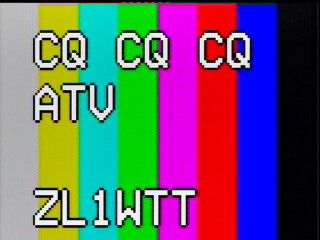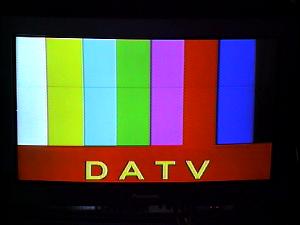

Project lists
Software based DATV
ATV controller
ATV Modulator
ATV Receiver
Linear Repeater
On-screen video display
PIC Colour bar pattern generator
Building and designing an ATV repeater
The DATV Data Repeater
Digital ATV testing with COFDM (DVB-T)
RF to Optical
Repeater layouts
Video processing
Other projects
Software based DATV
ATV controller
ATV Modulator
ATV Receiver
Linear Repeater
On-screen video display
PIC Colour bar pattern generator
Building and designing an ATV repeater
The DATV Data Repeater
Digital ATV testing with COFDM (DVB-T)
RF to Optical
Repeater layouts
Video processing
Other projects
Projects
Introduction
Besides various other transmission modes, licensed amateur radio operators are allowed to communicate by using pictures. This mode is usually called ATV for Amateur Television or Ham Television. The two most common ATV modes are SSTV (Slow Scan Television), where still images are transmitted in normal communications audio bandwidth and FSTV (Fast Scan Television) where normal live TV video is transmitted in a bandwidth of several Megahertz to tens of Megahertz. SSTV/NBTV is mostly used on the frequencies below 30 MHz, FSTV exclusively on the bands above 615 MHz (50 cm band). Radio amateurs usually use the general expression ATV for fast scan TV on the UHF and microwave bands. This is where our amateur television activities are focused. Modern day ATV can be in the form of analog or digital transmissions. ATV is one area in Ham radio today where we are at the cutting edge of technology and thinking.
This web-site covers 20 years of projects mostly ATV related, but there is a few others here as well. I have tryed to break these pages into parts consisting of text, diagrams and photos. In this way I hope this is in a form that is easier to understand. This subject of ATV is an area in the hobby where I keep coming up with concepts and ideas to experiment with. This is where the enjoyment comes from, pushing the limits of this technology and seen how far I can take it.
History of ATV in New Zealand
The history of channel 39 goes like this; the band came about from changes in the Amateur 70 cm band at the time it was 420 to 450 MHz. The lower 10 MHz was removed for commercial use, in return the Amateurs got access to unused UHF TV band, we ended up with 10 MHz of space between 610 to 620 MHz. Back at the start of 1980 when this all happened there was air traffic radar in this part of the spectrum up and down the country. This made this part of the UHF unusable for commercial television. This was what it was like up to the late 1980's. When the New Zealand Government decided to go with the UK UHF television band plan. This involved 8 MHz channels that went from 502 MHz (channel 25) up to 814 MHz (channel 63) at the same time our 50 cm band was shifted to channel 39 between 614 to 622 MHz. Also the air traffic radar systems were upgraded and moved up to 1310 and 1250 MHz making this block of UHF channels around channel 39 commercially viable. With pay TV making use of most of the UHF channels commercially and local TV stations needed more spectrum for their services. The other problem we have encountered over the last 30 years is the loss of 420 to 430 MHz and 20 after that we lost 440 to 450 MHz with no new replacement spectrum provided. In early 1990's we also lost the usable part of the 13 cm band from 2300 to 2396 MHz now left with so much WiFi interference this band is unusable in build up areas.
Our transmission standard here in NZ is DVB-T mode (COFDM 8k). For the new a DATV TV channel we have access to a new band (60cm). This will give us the freedom to use any type of modulation system we like, within the DVB-T/T2 format.
Auckland ATV Repeaters
Auckland ATV repeaters uses FM inputs and outputs to provide the best signal to noise performance, this is why the 70 cm band is no longer use for this reason. With the change to FM we now use dual sound sub-carriers at 6 and 6.5 MHz for stereo transmission. With deviation of 2.4 MHz giving a total bandwidth of 18 MHz. The 23 cm band has two frequencies set a side for ATV experimentation one at 1250 and the other at 1284 MHz.
My current projects
Universal down converter: The aim is to have a RF input range from 800 to 2450MHz and an IF output of 70MHz at 16MHz of bandwidth. Designed for both analog and digital transmissions.
Over the last three years I have been working on:
Auckland ATV reflector
For updated ATV activity checkout Yahoo groups under the name of akatv.
Besides various other transmission modes, licensed amateur radio operators are allowed to communicate by using pictures. This mode is usually called ATV for Amateur Television or Ham Television. The two most common ATV modes are SSTV (Slow Scan Television), where still images are transmitted in normal communications audio bandwidth and FSTV (Fast Scan Television) where normal live TV video is transmitted in a bandwidth of several Megahertz to tens of Megahertz. SSTV/NBTV is mostly used on the frequencies below 30 MHz, FSTV exclusively on the bands above 615 MHz (50 cm band). Radio amateurs usually use the general expression ATV for fast scan TV on the UHF and microwave bands. This is where our amateur television activities are focused. Modern day ATV can be in the form of analog or digital transmissions. ATV is one area in Ham radio today where we are at the cutting edge of technology and thinking.
This web-site covers 20 years of projects mostly ATV related, but there is a few others here as well. I have tryed to break these pages into parts consisting of text, diagrams and photos. In this way I hope this is in a form that is easier to understand. This subject of ATV is an area in the hobby where I keep coming up with concepts and ideas to experiment with. This is where the enjoyment comes from, pushing the limits of this technology and seen how far I can take it.
History of ATV in New Zealand
The history of channel 39 goes like this; the band came about from changes in the Amateur 70 cm band at the time it was 420 to 450 MHz. The lower 10 MHz was removed for commercial use, in return the Amateurs got access to unused UHF TV band, we ended up with 10 MHz of space between 610 to 620 MHz. Back at the start of 1980 when this all happened there was air traffic radar in this part of the spectrum up and down the country. This made this part of the UHF unusable for commercial television. This was what it was like up to the late 1980's. When the New Zealand Government decided to go with the UK UHF television band plan. This involved 8 MHz channels that went from 502 MHz (channel 25) up to 814 MHz (channel 63) at the same time our 50 cm band was shifted to channel 39 between 614 to 622 MHz. Also the air traffic radar systems were upgraded and moved up to 1310 and 1250 MHz making this block of UHF channels around channel 39 commercially viable. With pay TV making use of most of the UHF channels commercially and local TV stations needed more spectrum for their services. The other problem we have encountered over the last 30 years is the loss of 420 to 430 MHz and 20 after that we lost 440 to 450 MHz with no new replacement spectrum provided. In early 1990's we also lost the usable part of the 13 cm band from 2300 to 2396 MHz now left with so much WiFi interference this band is unusable in build up areas.
Our transmission standard here in NZ is DVB-T mode (COFDM 8k). For the new a DATV TV channel we have access to a new band (60cm). This will give us the freedom to use any type of modulation system we like, within the DVB-T/T2 format.
Auckland ATV Repeaters
Auckland ATV repeaters uses FM inputs and outputs to provide the best signal to noise performance, this is why the 70 cm band is no longer use for this reason. With the change to FM we now use dual sound sub-carriers at 6 and 6.5 MHz for stereo transmission. With deviation of 2.4 MHz giving a total bandwidth of 18 MHz. The 23 cm band has two frequencies set a side for ATV experimentation one at 1250 and the other at 1284 MHz.
My current projects
Universal down converter: The aim is to have a RF input range from 800 to 2450MHz and an IF output of 70MHz at 16MHz of bandwidth. Designed for both analog and digital transmissions.
Over the last three years I have been working on:
Phasing Quadrature Amplification
Made up of the Analog Digital Modulator (ADM), used for analog signal processing whin a Field Programmable Gate Array (FPGA), as part of a new switching amplifier using class-P and Class-Q.
Class Q, AM stereo broadcast transmitter
Phasing Quadrature AmplificationAuckland ATV reflector
For updated ATV activity checkout Yahoo groups under the name of akatv.



Copyright © 2019 by Grant ZL1WTT • All Rights reserved • [email protected]

I am now living in Canada with my new callsign of VE3XTV and VA3XTV for my repeater activities.
For updates on the greater Toronto area ATV Repeater project see Ontario-ATV

